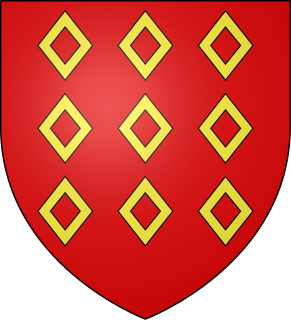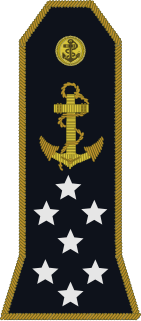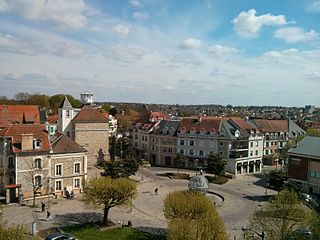Sources
- (in French) Genealogy of the Bureau family
Gaspard Bureau (died 1469) was a French ballistics expert and inventor, as well as lord of Montfermeil, Nogent-sur-Marne, Villemomble and other places. He was a brother of the artillery commander Jean Bureau.
Gaspard was the third son of Simon Bureau the Younger (Le Jeune), a merchant from Paris, and his wife Hélène. Jean and Gaspard joined Charles VII of France's army together in 1436. Gaspard was part of its financial administration as master of accounts, later becoming clerk of the artillery then temporary master of artillery in 1442. On 27 December 1444 he succeeded Pierre Bessonneau as grand-master of the king's artillery. He was ennobled by royal letters patent in October 1447.
Gaspard and John developed France's field artillery, standardising its calibre and switching it from wrought iron to cast iron. This gave the French army a decisive advantage over the English and helped bring an end to the Hundred Years' War. Gaspard took part in the 1450 siege of Bayeux and the battle of Castillon in 1453. On 21 March 1445 he bought the lordship of Villemomble from Francis I, Duke of Brittany for 9,000 livres tournois. He was made marquis of Castillon then a knight in 1464. He finally became captain of Beauté, Le Louvre and Poissy between 1463 and 1465.
He first married around 1440, to Guarix Burelle, with whom he had no children. His second marriage was around 1450, to Richarde de Vérines, with whom he had three daughters:

Gaspard de Coligny, Seigneur de Châtillon, was a French nobleman and Admiral of France, best remembered as a disciplined Huguenot leader in the French Wars of Religion and a close friend of—and advisor to—the French king, Charles IX.

Thury is a commune in the Yonne department in Bourgogne-Franche-Comté in north-central France, in the natural region of Forterre. Its inhabitants are called Thurycois and Thurycoises.

The Battle of Castillon was a battle fought on 17 July 1453 in Gascony near the town of Castillon-sur-Dordogne, between England and France. It was a decisive French victory and is considered to mark the end of the Hundred Years' War.

Jean Bureau was a French artillery commander active primarily during the later years of the Hundred Years' War. Along with his brother, Gaspard, he is credited with making French artillery the most effective in the world. As Master Gunner of Artillery in the armies of Charles VII, Bureau acquired a reputation as an effective artillery officer during the Normandy campaign (1449–1450), when his bombardments helped capture the towns of Rouen, Harfleur, and Honfleur, and aided in the French victory at Formigny. Bureau commanded the victorious French army at the decisive Battle of Castillon in 1453.

The House of Rohan is a Breton family of viscounts, later dukes and princes in the French nobility, coming from the locality of Rohan in Brittany. Their line descends from the viscounts of Porhoët and is said to trace back to the legendary Conan Meriadoc. Through the Porhoët, the Rohan are related to the Dukes of Brittany, with whom the family intermingled again after its inception. During the Middle-Ages, it was one of the most powerful families in the Duchy of Brittany. They developed ties with the French and English royal houses as well, and played an important role in French and European history.

Admiral of France is a French title of honour. It is the naval equivalent of Marshal of France and was one of the Great Officers of the Crown of France.

Nogent-sur-Marne is a commune in the eastern suburbs of Paris, France. It is located 10.6 km (6.6 mi) from the centre of Paris. Nogent-sur-Marne is a sous-préfecture of the Val-de-Marne département, being the seat of the Arrondissement of Nogent-sur-Marne.

Villiers-sur-Marne is a commune in the eastern suburbs of Paris, France. It is located 14.8 km (9.2 mi) from the center of Paris.

Le Perreux-sur-Marne is a commune in the Val-de-Marne department in the eastern suburbs of Paris, France. It is located 11.7 km (7.3 mi) from the center of Paris.

The Château de Champs is a neoclassical château in Champs-sur-Marne, France. It was built in its present form for the treasurer Charles Renouard de la Touane in 1699 by Pierre Bullet, architecte du roi. After the first proprietor's bankruptcy, another financier, Paul Poisson de Bourvalais, took up the project. Jean-Baptiste Bullet de Chamblain, the son of Pierre Bullet, finished Champs in 1706.

Nicolay - refer to Nobility particle) is a European noble family of the Ancien Régime with its roots in the south of France at the early part of the 14th Century. There is however, evidence to suggest that its origins stretch further back to the growth of the city state of Florence at the beginning of the Florentine Renaissance. The Nicolay family was originally associated with the French noble classes of the Nobles of the Robe and the Nobles of the Sword. It is well documented that members of the House of Nicolay became highly influential in the spheres of national government, law, the church, academia, military and diplomatic service, as well as the arts. They held the titles of marquis, count and baron.
François de La Trémoille (1505–1541) was a French nobleman of the La Tremoille family. He was the son of Charles I de la Trémoille and of Louise de Coëtivy.

Bussy-le-Château is a commune in the Marne department in the Grand Est region of north-eastern France.

Artillery began to be used in France in the 14th century. The first depiction of a cannon in Europe appeared in Walter de Milemete's 1326 De Nobilitatibus Sapientia et prudent Regum. Small rudimentary weapons such as the pot-de-fer or the portable bâton à feu were introduced. At this early stage, cannon would fire either stone balls or metal pellets.

Giovanni Francesco Mauro Melchiorre Salvemini di Castiglione FRS was an Italian mathematician and astronomer.
La Coupe de l'Outre-Mer de football 2010 was the 2010 edition of the Coupe de l'Outre-Mer. The competition took place from September 22, 2010 to October 2, 2010 in Île-de-France, France. It was Saint Pierre and Miquelon's first appearance in the tournament.

After the lifting of the Siege of Orléans and the decisive French victory at the Battle of Patay, the Anglo-Burgundian threat was ended. Joan of Arc convinced the Dauphin Charles to go to be crowned at Reims. The march though the heart of territory controlled by the hostile Burgundians was successful and would give the throne of the French monarchy to Charles VII, who had been ousted therefrom by the Treaty of Troyes.
John II, called Jean de L'Aigle, was Count of Penthièvre from 1433 until his death. He was also Count of Périgord from 1437.
Under the name Pierre Souffron are two brother architects from Périgord, sons of Jean Souffron.